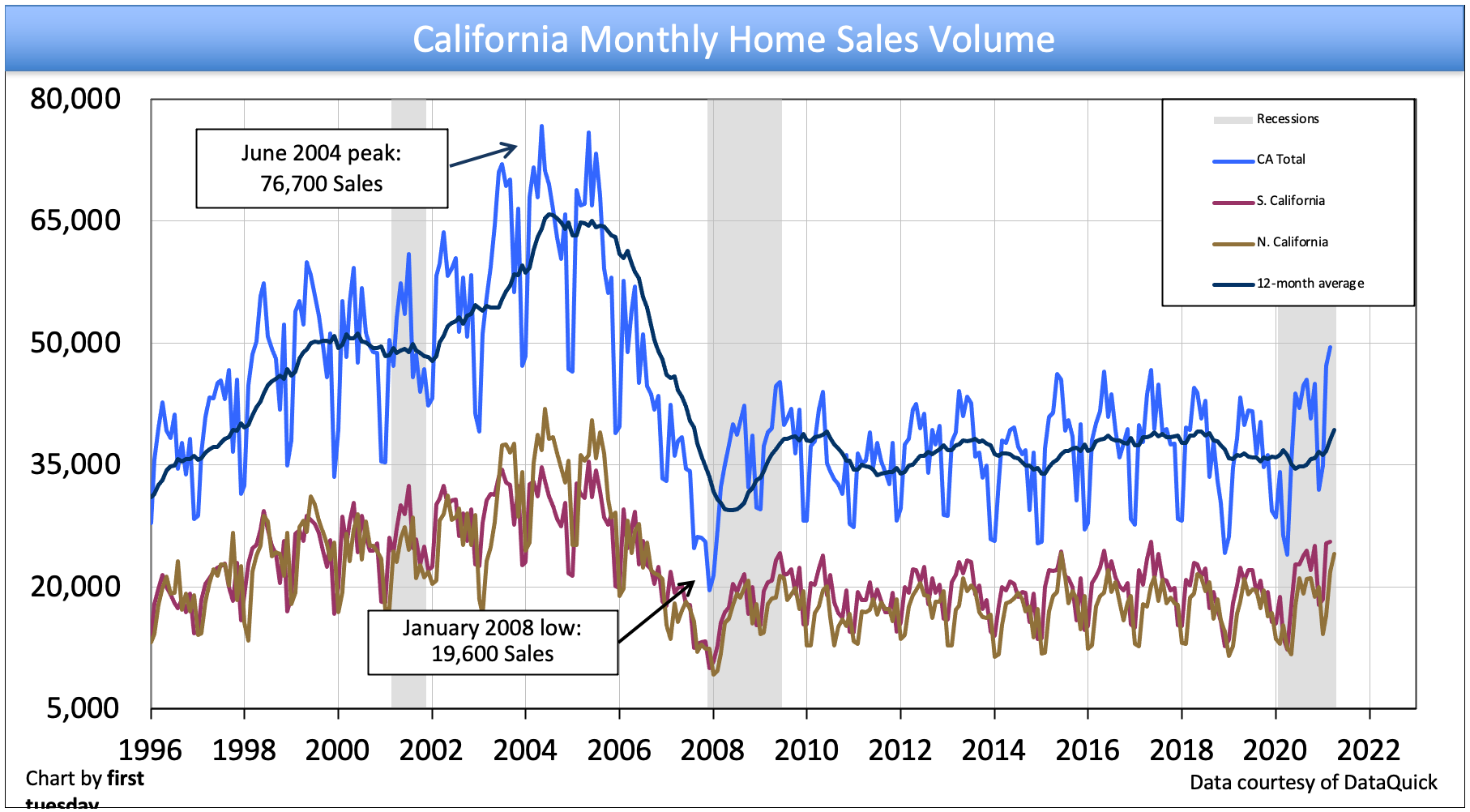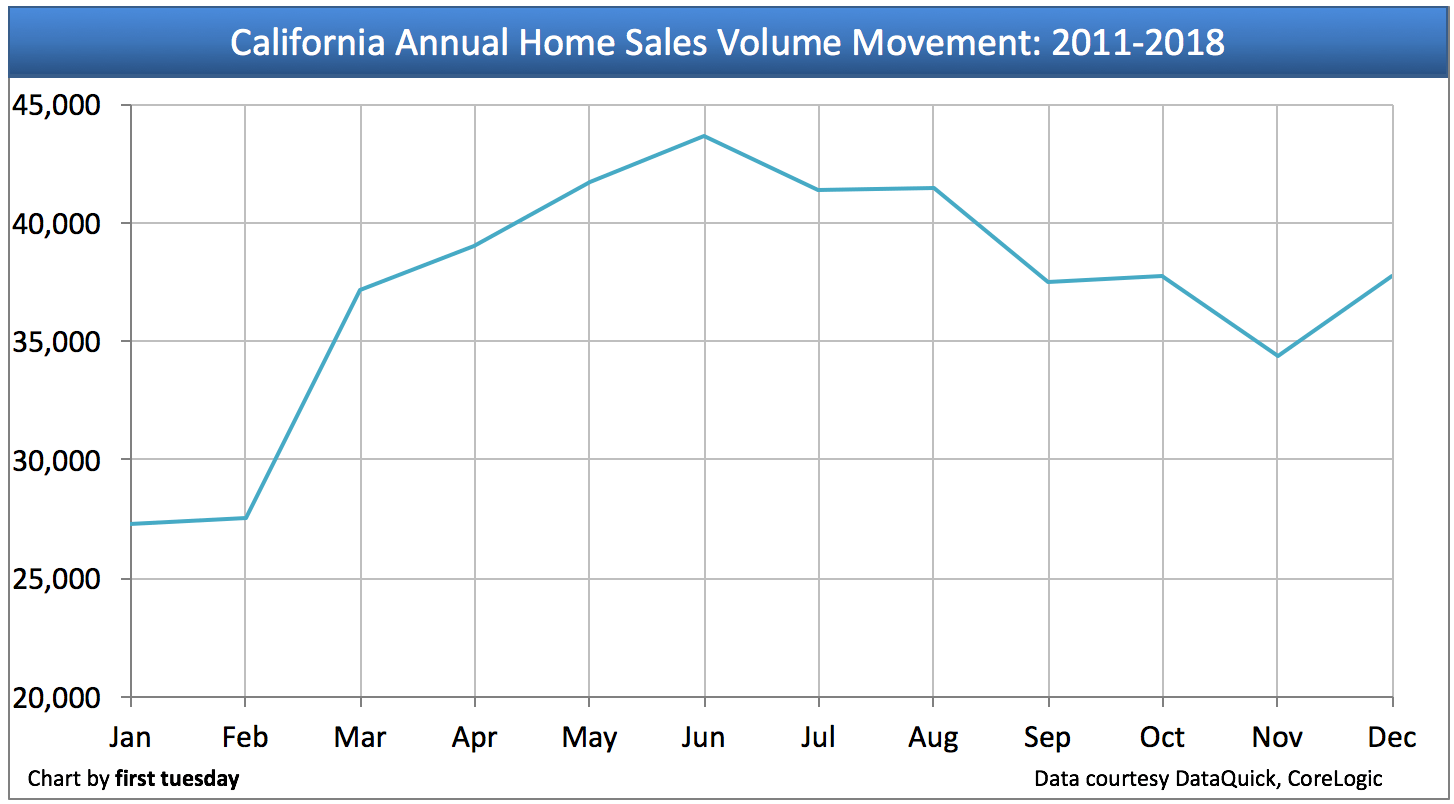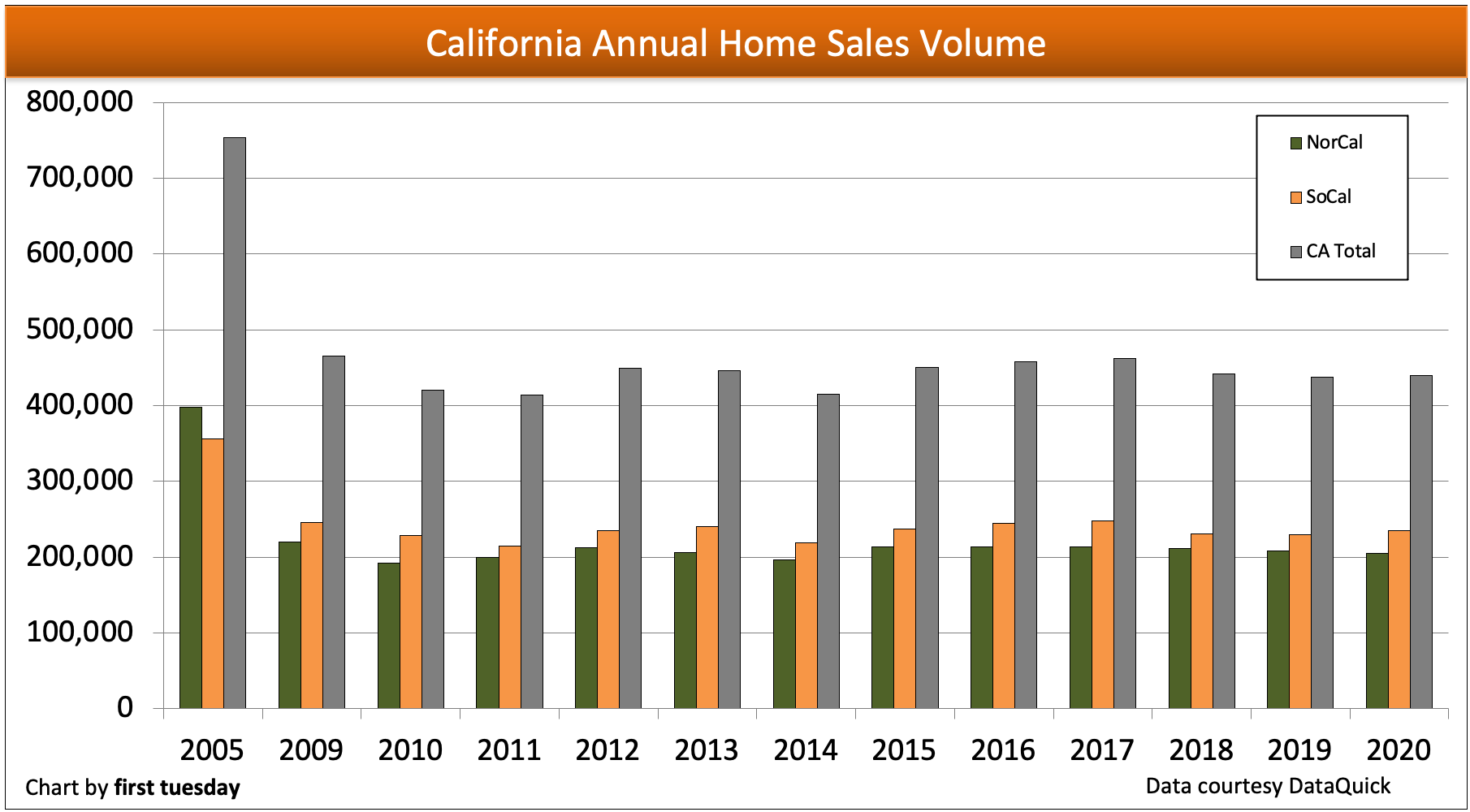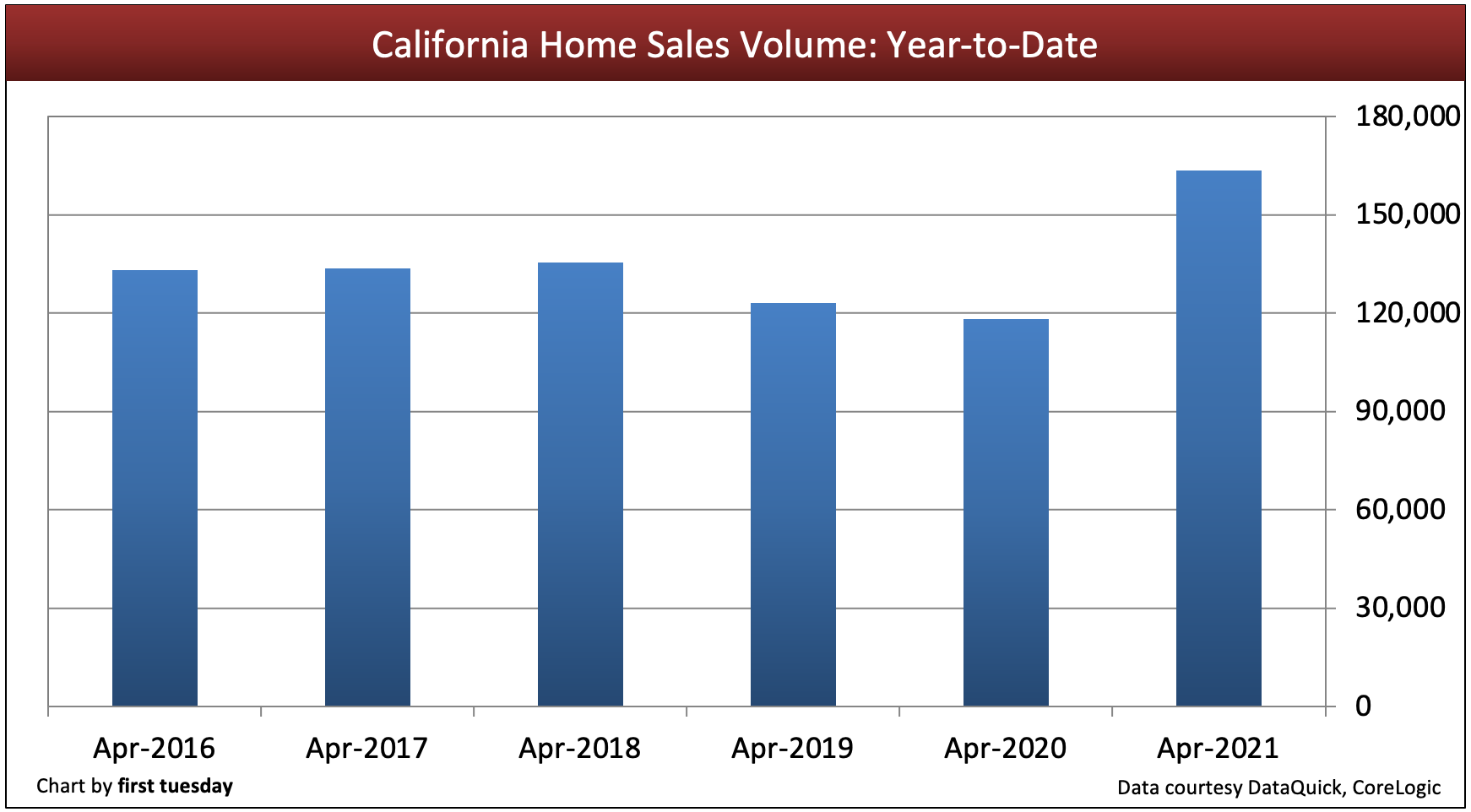49,500 new and resale home transactions closed escrow in California during April 2021. In this single month, the number of homes sold was a whopping 79% higher than a year earlier, when sales were at their lowest due to the pandemic’s emergence. April’s high sales numbers continue the rapid pace of sales experienced since mid-2020, uncharacteristic of a recession.
Despite the unique challenges presented by the ongoing recession and pandemic, many homebuyers merely delayed purchases in the first half of 2020, rather than cancelled them altogether. Encouraged by record-low interest rates and stimulus boosts, sales picked up by year’s end, and 2020’s annual home sales volume ended up roughly level with the prior year. Since then, home sales have only picked up speed, as homebuyers feed their growing fear-of-missing-out (FOMO).
2020 ended with 439,200 annual home sales in California. This was 1,700 more home sales than took place in 2019, amounting to a meager increase of 0.4%. 2020’s overall flat performance follows a 1% decrease in 2019 and a 4% decrease in 2018. For greater perspective, 2020’s 439,200 homes sales volume was 42% below peak sales volume experienced in 2005.
Today’s volatile home sales volume continues to destabilize the flow of agent fees. While still relatively low, fixed rate mortgage (FRM) rates have risen from historic lows in 2021, removing support for buyer purchasing power and home prices. Further, the coming expiration of the foreclosure moratorium in mid-2021 will release the buildup of distressed sales, which will drag down prices. Therefore, view 2021’s significant sales volume boost as temporary.
The housing market won’t begin a consistent recovery until well after the need for government intervention and the pandemic response have ended, a timeline which continues to shift. Then, California’s housing market will need to emerge from the underlying recession and recover the historic job losses of 2020, over half of which are still missing in Q1 2021. This stable recovery is not likely to even begin until around 2023-2024.
Updated June 10, 2021. Original copy posted March 2009.
Chart 1
 Chart update 06/10/21
Chart update 06/10/21
| Apr 2021 | Mar 2021 | Apr 2020 | |
| Southern CA | 25,500 | 25,400 | 13,900 |
| Northern CA | 24,000 | 21,800 | 12,500 |
CA Total | 49,500 | 47,200 | 26,300 |
The above chart tracks the home sales volume of single family residences (SFRs) on a month-to-month basis. Sales volume includes the sale of all residential resales and new homes in California, including new homes sold directly by builders.
Home sales vary from month-to-month for a variety of reasons, most significant being homebuyer demand. This demand is influenced by several factors constantly at work in California’s homebuying market, including:
- seasonal differences [see Chart 2];
- changes in home prices;
- mortgage interest rates;
- consumer confidence;
- the presence of investors and real estate speculators in the market;
- negative equity status;
- the quantity and quality of jobs held by homebuyers; and
- homebuyer saving rates.
Seasonal differences in annual sales volume
It’s normal for home sales volume to rise in the first half of the year and fall after June, generally speaking.
Chart 2

Chart update 02/02/19
Chart 2 shows average home sales as experienced from 2011-2018. As depicted, the most homes are regularly sold each year in June. Another small increase takes place in December, as homebuyers seek to wrap up their financial activities before the end of the year.
Therefore, real estate professionals are not to worry when they hear of falling sales volume in the latter half of the year. This is a normal seasonal progression. What to watch for is year-over sales comparing a month or other period (such as year-to-date) this year with the same month or period last year.
A very long recovery for home sales volume
Annual real estate sales numbers since the Great Recession of 2008 suggest the upcoming years through 2017 will be characterized by the same continuing bumpy plateau in home sales volume we have experienced now for eight stagnating years. As a rule, current market action, whether up or down, is reflected first in sales volume, followed by prices, and both fluctuate from month to month mostly going in opposite directions or just standing still.
Chart 3

Chart update 02/05/21
| 2020 | 2019 | 2018 | 2005 peak | |
| NorCal | 204,500 | 208,300 | 211,500 | 398,200 |
| SoCal | 234,700 | 229,200 | 230,400 | 355,700 |
| Total | 439,200 | 437,500 | 442,000 | 753,900 |
To set the stage for a forward look, a review of sales volume in the recent past is helpful:
- Mid-2005 saw sales volume peak for all types of real estate in California, with nearly 754,000 homes sold that year;
- Nearly 30% fewer sales were recorded in 2006 than in 2005, while sales dropped an additional 30% in 2007;
- sales bottomed in 2008 and were artificially inflated in 2009 due to subsidy-induced purchases and speculators jumping on the momentum, but remained 40% below 2005;
- 2010 saw a decline from the year earlier in both sales volume and prices;
- 2011 increased slightly in sales volume while decreasing in sales prices, a normal price adjustment condition;
- 2012 saw sales volume increase marginally and home prices jump significantly by year’s end, supported primarily by massive speculation;
- 2013 home sales volume stagnated, while home prices continued to increase rapidly, not a good sign for the immediate future; and
- 2014 saw home sales volume decrease throughout the year, ending the year 7% below 2013.
- 2015 ended 9% higher than 2014 — in other words, just about level with 2013. [See Chart 4]
- 2016 and 2017 sales volume continued a flat trend in sales which began in 2015;
- 2018 saw sales volume decrease rapidly in the fourth quarter, ending the year 4% below 2017;
- 2019 home sales volume decreased slightly from the prior year; and
- 2020 home sales were extremely volatile, dropping as much as 30% mid-year, but bouncing back sufficiently enough by Q3 and Q4 to make up for the loss, ending 2020 roughly level with 2019.
Chart 4

Chart update 06/10/21
| Apr 2021 | Apr 2020 | Apr 2019 | |
| Home sales volume year-to-date | 163,600 | 118,200 | 123,200 |
Year-to-date (YTD) home sales volume continues to climb, at 38% above a year earlier as of April 2021.
California home sales ended 2020 roughly level with the prior year, despite volatile dips and swings throughout this year characterized by a recession and pandemic. In total, 1,700 more home sales closed in California during 2020 than the prior year, amounting to an 0.4% increase in sales. 2020’s flat performance continues years of stagnant sales volume following the profitable years of the Millennium Boom.
Despite the sales volume jump experienced in 2021, home sales are expected to fall back in 2022, due to:
- lower homeowner turnover to buy an upgrade or relocate due to negative equity (once the foreclosure moratorium ends in 2021 and distressed sales drag down home values);
- reduced home inventory across the state; and
- the job losses of 2020, half of which are still absent from the jobs market in Q1 2021.
These disadvantages are due to the jobs recovery which has been dragged out for eight years now, a confidence issue, and is pronounced by wage increases below the rate of consumer inflation. California finally regained all jobs lost in the 2008 recession in mid-2014, but did not return to pre-recession employment levels after considering the 1.1 million working-aged population increase until 2019 – just in time for job losses to hit in 2020.
Short sales, real estate owned (REO) property resales and speculators have contributed to sales volume distortion over the past few years. Conventional positive-equity resales by owner-occupants were the exception, sometimes reminiscently called standard sales as opposed to short sales. As prices rise, move-up homeowners will return to the market to sell and concurrently buy a more suitable replacement home.
When home prices fall, many California mortgaged homeowners will fall underwater. Thus, turnover by this chunk of owners will be restricted. These homeowners cannot sell and relocate to purchase another home because their homes are worth less than the debt encumbering them. To rid themselves of the home and the debt, they have to endure damaged credit resulting from a short sale or foreclosure. The desire to avoid this embarrassment takes most of these 3.2% homeowners out of the home buying market for years.
Home sales in the coming years
The forward trend in California home sales is mixed for both buyers and seller. Homebuyer income is going further and doing more than anytime during the past 15 years due to increased borrowing capacity brought on by low interest rates, at historic lows in May 2020.
first tuesday forecasts home sales volume will languish in 2020-2021, the result of an unstable jobs market. The peak sales volume last seen in 2004, inflated by speculator acquisitions and excessive mortgage money, is unlikely to return for decades, when interest rates cyclically peak.
Relocating Baby Boomers going into retirement in the coming years will be the primary propelling force in both selling homes and buying replacements. Their Generation Y (Gen Y) children will add to the sales volume at the same time as they find jobs at better pay levels and become first-time homebuyers. Gen Y influence will peak in sales volume at the end of this decade as they complete their shift from renting to owning.
Once California’s job market rebounds from the current recession, their confidence about the future will improve. They will once again be willing to invest in the economy since the expectations for tomorrow are projections based on yesterday’s most recent experience. Only then will occupying homebuyers – end users – return in sufficient numbers for sales volume to swell significantly.
Employment and labor force participation finally exceeded their 2007 peak in 2019, but what took over a decade to recover was lost in a matter of weeks due to COVID-19-induced lay-offs. Expect home sales volume to decrease along with jobs through the rest of 2020 and 2021.
Trends to be concerned about
Many long-term unfavorable market conditions restrain the rise of home sales volume:
- the weakest homebuyer demographics in 15 years;
- failed savings for a down payment as high rents squeeze potential first-time homebuyers out of saving;
- buyer borrowing power no longer enlarging the funds they can borrow as interest rates inevitably rise, reducing funding for purchase-assist financing and dampening property prices;
- the public’s increasingly anti-business and pessimistic attitude about American economics, wealth inequality and national politics no matter the outcomes; and
- tightened loan standards as lenders are forced to apply forgotten fundamentals of sound mortgage lending practices (20% down payment on non-FHA/private mortgage insured loans, lower income ratios, risk-free credit scores and full documentation of income, funds and collateral value).
The competitive broker
What’s a broker to do until home sales volume takes off?
SFR brokers and agents might consider adding SFR-related services to supplement their income. Those who do add related services will restructure their practice as “all-service brokers.” Transaction-related services will be integrated into their office operations to maintain solvency and grow.
Related article:
These services include:
- escrowing their in-house transactions under the broker’s license;
- entering into or expanding property management services;
- negotiating equity purchases for investors from underwater owners on the chance of a short sale discount or who have a positive equity;
- specializing in sales and leasing of a particular type of commercial property, other branch office locations and alternative marketing approaches (aside from social media);
- providing mortgage loan broker services for business-investor loans made by private lenders and secured by the borrower’s residence (no mortgage loan origination (MLO) endorsement required);
- arranging carryback financing and the take over/assumption of existing mortgages, and buying and selling those carryback trust deed notes;
- negotiating options to buy, or lease with option to buy when inventories expand as the shadow inventory of speculators returns to be sold;
- exchanging properties with equity to help owners relocate their wealth held in real estate tax free; or
- using barter credits in lieu of greenbacks, etc.
Prudent brokers will insist their prospective buyers commit to exclusive representations by the broker and agent to locate a home (or other property). By signing an exclusive right-to-buy listing agreement, buyers commit to employ brokers and agents just as sellers commit to employ brokers and agents, the obverse side of the same employment coin. This will ensure time spent with a buyer produces a closing and a fee.

